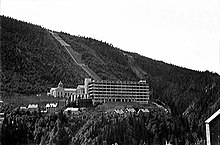Joachim Rønneberg
Joachim Holmboe Rønneberg | |
|---|---|
First Lieutenant | |
| Unit | Norwegian Independent Company 1 |
| Battles/wars |
|
| Awards |
|
| Spouse(s) |
Liv Foldal (m. 1949) |
| Relations | Alf Rønneberg (father) Anna Krag Sandberg (mother) NRK broadcaster |
Joachim Holmboe Rønneberg
Personal life
Rønneberg was born in
During his childhood, he was a member of scout movement.
Career
Rønneberg reported for national service in 1938, being told to report for duty with the surveying department in 1940.[11]
World War II
Heavy water sabotage

Rønneberg, now a
After the factory was reported to have been rebuilt in the summer of 1943 a new saboteur attack was planned, but eventually scrapped in favour of an
The sabotage action against the Vemork plant was portrayed in the Franco-Norwegian 1948 film
Other World War II work
Rønneberg subsequently commanded other raids against the Germans, including the Fieldfare operation in Sunnmøre,[13] in preparation for attacks against German supply lines in the Romsdal valley.[24] In January 1945 Rønneberg had led a three-man unit of NOR.I.C.1 on a mission to destroy the Stuguflåt railway bridge, blowing up the bridge with a 130-kilogram (290 lb) charge of plastic explosives, putting it out of service for three weeks. The team then escaped without casualties.[25] His service with NOR.I.C.1 ended with the liberation of Norway in 1945.[1]
Honours and awards
In 1943, he was awarded Norways's highest decoration for military gallantry, the
Post-war career
After the war he began a career in broadcasting. He was hired in
In his later years Rønneberg was involved in war information work, holding lectures for audiences around Norway. He said that he was particularly fond of holding talks for school children. Rønneberg was highly critical of the current situation for the Norwegian military, stating that its capacity for mobilisation was only 9% of the 1990 level.[11] In 1995, Rønneberg, together with fellow World War II resistance leader Gunnar Sønsteby and Norwegian businessman Erling Lorentzen, received the Norwegian-American Chamber of Commerce Achievement Award for "individuals whose outstanding personal accomplishments exemplify the spirit of commitment, perseverance and endeavor that sustains the strong relations between Norway and the United States of America".[33] Rønneberg was a member of the Linge Club, a Norwegian veterans' association, until it was disbanded on 17 October 2007.[34] In April 2013, Rønneberg was presented with a Union Jack during a ceremony at the Special Operations Executive (SOE) monument in London to mark 70 years since the successful Gunnerside mission.[35]
Bibliography
- ISBN 978-1444798982.
- ISBN 978-8299102643.
- ISBN 978-8270102457.
- ISBN 978-8203293061.
- "WWII Hero Credits Luck and Chance in Foiling Hitler's Nuclear Ambitions". NY Times. 20 November 2015. Retrieved 20 November 2015.
- ISBN 978-1786482082.
References
- ^ Store norske leksikon(in Norwegian). Retrieved 7 January 2013.
- ^ Family genealogy Archived 3 March 2016 at the Wayback Machine (vestraat.net). Retrieved on 10 November 2008.
- ^ Midttun, Lasse (10 May 1995). "Det tunge valget" (in Norwegian). Archived from the original on 17 July 2011. Retrieved 23 July 2008.
- ^ a b c Kraglund, Ivar. "Joachim Rønneberg". In Helle, Knut (ed.). Norsk biografisk leksikon (in Norwegian). Oslo: Kunnskapsforlaget. Retrieved 7 January 2013.
- ^ Madsen, Roar. "Ole Rømer Sandberg". In Helle, Knut (ed.). Norsk biografisk leksikon (in Norwegian). Oslo: Kunnskapsforlaget. Archived from the original on 23 February 2013. Retrieved 7 January 2013.
- ^ Lucký, Jakub (17 February 2023). "Interview with Victor Rønneberg". iRozhlas.cz. Czech Radio. Retrieved 17 February 2023.
- ^ Joachim Holmboe Rønneberg genealogy Archived 3 March 2016 at the Wayback Machine. Retrieved on 10 November 2008.
- ^ Norwegian tax lists, 2007. Retrieved on 10 November 2008.
- ^ "Krigsveteranen Joachim Rønneberg er død, 99 år gammel". Avisen Agder (in Norwegian). 21 October 2018. Archived from the original on 21 October 2018. Retrieved 21 October 2018.
- ^ "Joachim Roenneberg, Who Sabotaged Nazis' Nuclear Hopes, Dies At 99". NPR.org. Retrieved 25 October 2018.
- ^ a b c d "Joachim Rønneberg: "Kanskje var fremtiden vår kort i 1940"" (in Norwegian). Norsk Forsvarsforening. Archived from the original on 13 October 2007. Retrieved 10 November 2008.
- ^ Daily Telegraph. Retrieved 19 November 2017.
- ^ ISBN 9788202141387.
- ^ Voksø 1994: 309
- ^ a b c Moland 1987: 9
- ^ a b Voksø 1994:311
- ^ "1943: Bomberegn og "bestilt" sabotasje" (in Norwegian). Norsk Hydro. 13 September 2007. Retrieved 10 November 2008.
- ISBN 9788202141387.
- ISBN 9788202141387.
- ^ Moland 1987:9–10
- ^ Jorn Rossing Jensen (21 November 2014). "NRK ready to declare €8.7 million Heavy Water War". Cineuropa. Retrieved 15 June 2016.
- ^ "Kampen om tungtvannet – Norsk film fra 1948" (in Norwegian). filmfront.no. Retrieved 10 November 2008.
- Internet Movie Database. Retrieved 10 November 2008.
- ^ "Historiske kull Rønneberg!". Milnytt.no (in Norwegian). 11 July 2006. Retrieved 10 November 2008.[dead link]
- ^ Setså, Trond (2006). "Lingetreffen på Dombås" (PDF). Heimevernsbladet (in Norwegian). 59 (4): 38.[permanent dead link]
- ^ "Krigskorset" (in Norwegian). Archived from the original on 27 March 2010. Retrieved 11 November 2008.
- ^ a b I kamp for frihet (Norwegian documentary film), Filmlight Video Produksjon & NRK, 2001
- ISBN 978-0-563-53734-2.
- ^ "Heidra motstandsmann". www.royalcourt.no. Retrieved 20 April 2022.
- ^ "Stiftelsen av Hafrsfjord Rotary Klubb i 1971" (in Norwegian). Hafrsfjord Rotary Klubb. 9 August 1998. Retrieved 11 November 2008.
- ^ "Innsatstyrke Archery besøker Fieldfarehytta i Tafjordfjella" (in Norwegian). Norwegian Armed Forces. 7 November 2007. Archived from the original on 16 June 2007. Retrieved 10 November 2008.
- ^ "Fieldfarehytta" (in Norwegian). Norwegian Trekking Association. Retrieved 10 November 2008.
- ^ "About NACC > Awards". Norwegian-American Chamber of Commerce, Inc. Archived from the original on 31 July 2007. Retrieved 11 November 2008.
- Norwegian Ministry of Defence. 17 October 2007. Retrieved 11 November 2008.
- ^ "Agent who sabotaged Nazi atomic program honoured in London". Australian Broadcasting Corporation (ABC). 26 April 2013. Retrieved 26 April 2013.
External links
- Joachim Rønneberg at IMDb
